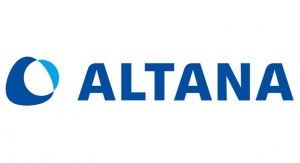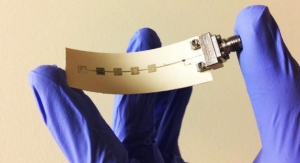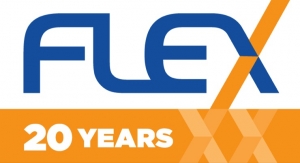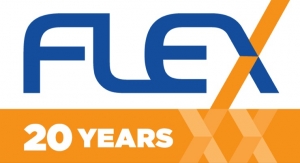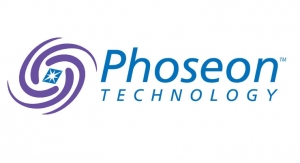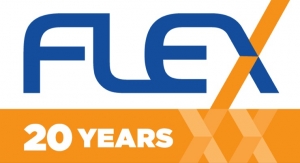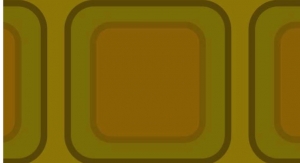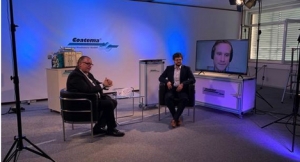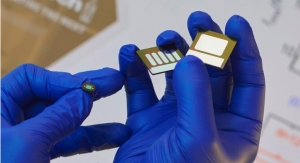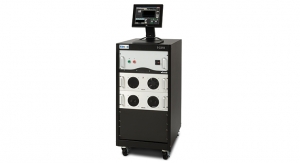David Savastano, Editor11.01.17
The Inkjet Conference (TheIJC), which was held Oct. 23-24, 2017 in Dusseldorf, Germany, featured a record number of presenters, exhibitors and attendees. For the first time, TheIJC featured a Plenary session as well as three concurrent tracks.
Organizers and exhibitors all said that TheIJC conference was a success this year. ESMA CEO Peter Buttiens, who co-organizes the show with co-founder Steve Knight, said that TheIJC has been an enormous success.
“In four years, we have almost doubled the number of presentations and more than doubled the number of tabletops, with 36 new tabletops this year,” said Buttiens. “In addition, 74 new companies sent delegates this year, with 195 new attendees.
“The number of exhibitors and delegates bring together so many possibilities,” added Buttiens. “The level of presentations was exceptional. We have been reinventing TheIJC every year. We went to the Plenary sessions and three tracks this year. We don’t want repetition from year to year. We have 40% new exhibitors, and they bring new subjects. We have 60% more delegates. It is the platform for inkjet.”
“The people who joined us here really make the event very enjoyable to see companies and the exchange of ideas going on,” noted Knight. “The people in this industry are making this possible. We can see the effort that went into the presentations. This is the biggest inkjet technical event in the world. People who are here are building the future.”
Flexible and Printed Electronics
Inkjet and Aerosol Jet printing are becoming more mainstream when it comes to flexible and printed electronics, and TheIJC had some interesting talks aimed at this growing opportunity.
Simon Daplyn of Sensient discussed “Digitising the Printing Process for Flooring, Furnishing and other Functional and Industrial Applications,” covering the possibilities of functional printing.
“Every substrate has different nuances,” Daplyn said. “Ink requirements include high printing reliability and consistency, with little downtime and maintenance, and you need performance at production speeds. Printhead and system compatibility is important, as is regulatory. Price is a massive consideration, but quality and reliability should also be a consideration.
“One industry that is wide open for inkjet is printed circuit board manufacturing, as inkjet is additive,” Daplyn added. “You can eliminate photomasks – more environmentally friendly and simplifies manufacturing. Other uses for inkjet are 3D printing, contact lenses, deposit resins for sandpaper, solar, color filters for screens, flexible electronics and OLED displays. Digtial print is ideal in a materials deposition tool within a manufacturing process.”
Dr. Kerstin Gläser of Hahn-Schickard Society discussed “Inkjet and Aerosol Jet in the Field of Microtechnology.”
“Printed sensors include temperature sensors, strain sensors, intrusion sensors, magnetic field, gas and touch sensors,” Dr. Glaser said. “Inkjet can be used to print these sensors. I think inkjet has a chance in printed electronics but there are some challenges.”
Enrico Sowade of Chemnitz University of Technology closed Track 3 with “Inkjet Printing Technology for Printing Functional Layers.” Sowade showed a range of inkjet-printed electronic devices, including resistors, capacitors, diodes, antennas and thin-film transistors, printed sieves for filter applications, printed self-assembled monolayers and others.
“We are using piezo inkjet technology for doing functional printing because we need high flexibility,” Sowade said. “We have sheetfed and web-fed printing capabilities. For printed resistors, we use silver nanoparticle inks and Fujifilm Dimatix printheads to print thousands of printed resistors with a yield of close to 100%. We have determined that yield decreases with resistor length. We sinter the nanoparticles to create the dry electrical conductive layer. We also printed several hundred antennas and coils, as well as capacitors.”
Sowade reported that inkjet printing has potential in the printed electronics market. “Inkjet printing is a fully additive process where the ink is deposited only at positions where it is required,” he added. “It is a flexible and reliable technology.”
Other Highlights
Kodak’s Dan Denovsky opened the first day’s Plenary session with his talk on “Expanding the Boundaries with Continuous Inkjet.” He began with a brief history lesson on digital printing technologies, and Kodak’s focus on water-based pigment inks, which can print on almost any surface.
“Digital printing has been a complement and replacement for offset for 50 years,” Denovsky said. “Mainstream technology has to replace the incumbent technology. It has to have image quality, productivity and cost to replace the incumbent technology.
“Our first generation of digital printing was continuous inkjet, which was founded when we were a division of Mead,” Denovsky continued. “The division was sold to Kodak, which formed Diconix. That, in turn, was sold to Scitex, and then was reacquired by Kodak in 2004. The second generation was Versamark. The third generation was Stream, which debuted at drupa 2008. Ultrastream debuted at drupa 2016, and prints 4 picoliter drops, 600 to 1800 dpi resolution and 500 feet per minute. With Ultrastream, we now have sheetfed offset class quality.”
HP’s Craig Olbrich gave a talk on “Thermal Inkjet Printhead Technology for Industrial Print.” Olbrich noted that thermal inkjet has been a staple of consumer and office printing for three decades, and HP is using its scalable printhead technology to grow into industrial applications.
“HP dye-based inks have an excellent color that is good for home printing, while our pigmented inks are ideal for color office printing,” Olbrich said. “Latex is good for signage, and is environmentally friendly, and solvent-based inkjet inks are designed for packaging.”
One area where HP has evolved is the number of nozzles in its printheads.
“We have been focused on adding nozzles to our printheads over the years,” he observed. “In 1984, our ThnkJet had 12 nozzles. Today, our new PageWide Pro X B/A3 has 56,000 nozzles. For 30 years, the performance of our HP thermal inkjet printheads has doubled every 18 months.”
After the Plenary Session, TheIJC broke off into three concurrent tracks. Among the speakers in Track 1 was Dr. Veena Sarojiniamma of Industrial Inkjet, who discussed “Inkjet for High Speed Wallpaper Applications.” Dr. Sarojiniamma noted that new developments in single-pass digital printing have opened up opportunities for interior designs.
“Digital printing is a small portion of the wallcovering market, but wallcoverings are growing in popularity,” Dr. Sarojiniamma said. “Digital can be customized and offers short runs, and producers are looking for something new. The wallpapering market requirements are extreme. It requires high jetting reliability, low gloss, good wash/scrub resistance, meets regulatory standards and be low cost. Still, there is a real demand for digital.”
Track 2 opened with “Drivers and Requirements for Next Generation Digital Textile Inks,” by Dr. Hamid M. Shirazi of Fujifilm Imaging Colorants. Dr. Shirazi noted that in the 1850s, Sir William Perkin developed the first dye, which led to his further discoveries in organic chemistry. By 1900, more than 2,000 colorants were developed.
Dr. Shirazi then discussed the different types of textile inks and the differences between dyes and pigments.
“A dye is a single molecule, and pigments are particles, which are more lightfast,” he noted. “Textile ink usage depends upon the fabric. For cellulosic inks like cotton or linen, reactive dyes are used. Acid dyes are used for polyamide fabrics like nylon or silk. Direct dyes are ideal for leather or paper. Dispense dyes are for polyester, and pigments for multi-fiber applications. Pigmented inkjet inks are very good for lightfastness, which is useful for outdoor applications and fabrics.”
Dr. Shirazi then discussed the advantages of inkjet printing of textiles.
“Digital printing for textiles are ideal for sampling and proofing, short runs, inventory management, fast fashion and fashion cycles, personalization and customization and e-commerce,” he observed. “Analog is not agile or flexible. If a rotary screen printer has 10,000 designs, they have to keep 40,000 screens in stock. Meanwhile, e-commerce requires that customer receives their order within 48 to 72 hours of ordering.”
Klaus Ruhmer of Meyer Burger discussed “Semiconductor Packaging is Changing Due to Inkjet Technology,” which discussed why inkjet printing is being adopted by some of the largest global semiconductor producers.
Day 2 Highlights
The Oct. 25 Plenary Session opened with Dr. Dan Mace of Archipelago Technology, who discussed “Widening the Window: Powerdrop’s Approach to Opening Up Inkjet.”
Dr. Mace noted that people are jetting a wide range of materials, including inks, paint, primers, adhesives, food and biomaterials. The Powerdrop print drum can jet viscous materials such as UV varnish, corrosive pre-coats and hot melt adhesives.
“These materials can be viscous, corrosive, abrasive and require elevated temperature, but many of these materials complement inkjet, like primers and overprint varnishes,” he added. “We are working on primers for carton board and flexibles, overprint varnishes for protecting packaging and products and glaze for tiles, and creating new products like adhesives for packaging and manufacturing products, and paint for decorations and coatings.”
Dr. Marc Graindourze of AGFA discussed “Industrial Inkjet Printing Solutions from the Perspective of the Ink Design.” He noted that Agfa’s UV inks are used in decoration, product printing, packaging, marking and coding and variable data documents and labels, and offered three examples of inkjet printing.
“Decoration of laminates allows personalization with a UV ink on top of the laminate with varnish on top for protection,” said Dr. Graindourze. “It also allows production of new designs, short runs and variable runs. It is replacing gravure printing, as inkjet offers short runs using water-based inks.”
Packaging is another important market for inkjet.
Packaging, including labels, direct-to-shaped packaging such as tubes and boxes, migration-sensitive packaging and pharma packaging, are important markets for AGFA’s UV inks.
“You have to select the ink by application, substrate and process,” said Dr. Graindourze. “example, last stage printing of a box allows you to print exact amounts with variable box sizes and image changes. Ink is a key element to the print solution.”
“UV inkjet is a proven technology – it is extremely reliable, and we are over 200 meters a minute today,” he added. “I’m a strong believer in UV. UV inks can fit a large variety of applications.”
Thoughts on TheIJC
Exhibitors agreed that TheIJC Conference continues to grow in influence. Sun Chemical has been attending since the conference began in 2014, and Peter Saunders, global business director Digital for Sun Chemical, said the growth is noticeable.
“It is a heck of a lot larger than it originally was,” said Saunders. “This year feels a lot bigger. There’s a lot of new faces here. For us, it is most important that the OEM equipment and printhead manufacturers are here, as these relationships are critical.”
“It is amazing how this conference has developed since 2014. It has grown by three to four times with more people coming,” added Matthew Schieber, product manager, solvent- and water-based inks for Marabu. “We have many of our R&D people here. We see collaboration partners here and are working on projects with people we have met at previous shows. This show is increasing in value.”
Next year, TheIJC will hold its first conference in the US, from April 12-13 at The Westin O'Hare in Chicago, IL. For more information, contact ESMA at [email protected]or [email protected].
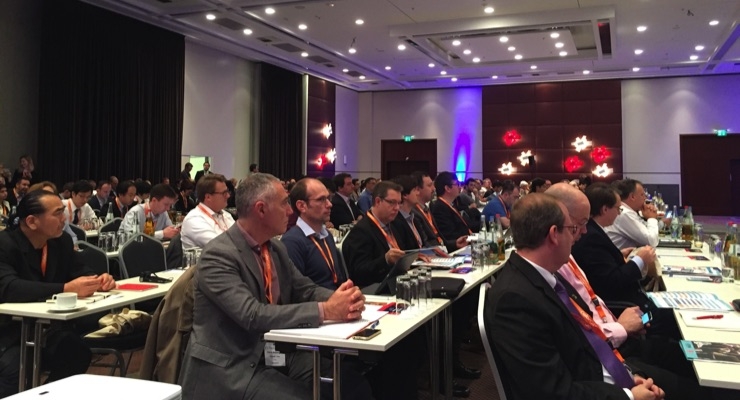
Attendees enjoy the first Plenary session during TheIJC 2017.
Organizers and exhibitors all said that TheIJC conference was a success this year. ESMA CEO Peter Buttiens, who co-organizes the show with co-founder Steve Knight, said that TheIJC has been an enormous success.
“In four years, we have almost doubled the number of presentations and more than doubled the number of tabletops, with 36 new tabletops this year,” said Buttiens. “In addition, 74 new companies sent delegates this year, with 195 new attendees.
“The number of exhibitors and delegates bring together so many possibilities,” added Buttiens. “The level of presentations was exceptional. We have been reinventing TheIJC every year. We went to the Plenary sessions and three tracks this year. We don’t want repetition from year to year. We have 40% new exhibitors, and they bring new subjects. We have 60% more delegates. It is the platform for inkjet.”
“The people who joined us here really make the event very enjoyable to see companies and the exchange of ideas going on,” noted Knight. “The people in this industry are making this possible. We can see the effort that went into the presentations. This is the biggest inkjet technical event in the world. People who are here are building the future.”
Flexible and Printed Electronics
Inkjet and Aerosol Jet printing are becoming more mainstream when it comes to flexible and printed electronics, and TheIJC had some interesting talks aimed at this growing opportunity.
Simon Daplyn of Sensient discussed “Digitising the Printing Process for Flooring, Furnishing and other Functional and Industrial Applications,” covering the possibilities of functional printing.
“Every substrate has different nuances,” Daplyn said. “Ink requirements include high printing reliability and consistency, with little downtime and maintenance, and you need performance at production speeds. Printhead and system compatibility is important, as is regulatory. Price is a massive consideration, but quality and reliability should also be a consideration.
“One industry that is wide open for inkjet is printed circuit board manufacturing, as inkjet is additive,” Daplyn added. “You can eliminate photomasks – more environmentally friendly and simplifies manufacturing. Other uses for inkjet are 3D printing, contact lenses, deposit resins for sandpaper, solar, color filters for screens, flexible electronics and OLED displays. Digtial print is ideal in a materials deposition tool within a manufacturing process.”
Dr. Kerstin Gläser of Hahn-Schickard Society discussed “Inkjet and Aerosol Jet in the Field of Microtechnology.”
“Printed sensors include temperature sensors, strain sensors, intrusion sensors, magnetic field, gas and touch sensors,” Dr. Glaser said. “Inkjet can be used to print these sensors. I think inkjet has a chance in printed electronics but there are some challenges.”
Enrico Sowade of Chemnitz University of Technology closed Track 3 with “Inkjet Printing Technology for Printing Functional Layers.” Sowade showed a range of inkjet-printed electronic devices, including resistors, capacitors, diodes, antennas and thin-film transistors, printed sieves for filter applications, printed self-assembled monolayers and others.
“We are using piezo inkjet technology for doing functional printing because we need high flexibility,” Sowade said. “We have sheetfed and web-fed printing capabilities. For printed resistors, we use silver nanoparticle inks and Fujifilm Dimatix printheads to print thousands of printed resistors with a yield of close to 100%. We have determined that yield decreases with resistor length. We sinter the nanoparticles to create the dry electrical conductive layer. We also printed several hundred antennas and coils, as well as capacitors.”
Sowade reported that inkjet printing has potential in the printed electronics market. “Inkjet printing is a fully additive process where the ink is deposited only at positions where it is required,” he added. “It is a flexible and reliable technology.”
Other Highlights
Kodak’s Dan Denovsky opened the first day’s Plenary session with his talk on “Expanding the Boundaries with Continuous Inkjet.” He began with a brief history lesson on digital printing technologies, and Kodak’s focus on water-based pigment inks, which can print on almost any surface.
“Digital printing has been a complement and replacement for offset for 50 years,” Denovsky said. “Mainstream technology has to replace the incumbent technology. It has to have image quality, productivity and cost to replace the incumbent technology.
“Our first generation of digital printing was continuous inkjet, which was founded when we were a division of Mead,” Denovsky continued. “The division was sold to Kodak, which formed Diconix. That, in turn, was sold to Scitex, and then was reacquired by Kodak in 2004. The second generation was Versamark. The third generation was Stream, which debuted at drupa 2008. Ultrastream debuted at drupa 2016, and prints 4 picoliter drops, 600 to 1800 dpi resolution and 500 feet per minute. With Ultrastream, we now have sheetfed offset class quality.”
HP’s Craig Olbrich gave a talk on “Thermal Inkjet Printhead Technology for Industrial Print.” Olbrich noted that thermal inkjet has been a staple of consumer and office printing for three decades, and HP is using its scalable printhead technology to grow into industrial applications.
“HP dye-based inks have an excellent color that is good for home printing, while our pigmented inks are ideal for color office printing,” Olbrich said. “Latex is good for signage, and is environmentally friendly, and solvent-based inkjet inks are designed for packaging.”
One area where HP has evolved is the number of nozzles in its printheads.
“We have been focused on adding nozzles to our printheads over the years,” he observed. “In 1984, our ThnkJet had 12 nozzles. Today, our new PageWide Pro X B/A3 has 56,000 nozzles. For 30 years, the performance of our HP thermal inkjet printheads has doubled every 18 months.”
After the Plenary Session, TheIJC broke off into three concurrent tracks. Among the speakers in Track 1 was Dr. Veena Sarojiniamma of Industrial Inkjet, who discussed “Inkjet for High Speed Wallpaper Applications.” Dr. Sarojiniamma noted that new developments in single-pass digital printing have opened up opportunities for interior designs.
“Digital printing is a small portion of the wallcovering market, but wallcoverings are growing in popularity,” Dr. Sarojiniamma said. “Digital can be customized and offers short runs, and producers are looking for something new. The wallpapering market requirements are extreme. It requires high jetting reliability, low gloss, good wash/scrub resistance, meets regulatory standards and be low cost. Still, there is a real demand for digital.”
Track 2 opened with “Drivers and Requirements for Next Generation Digital Textile Inks,” by Dr. Hamid M. Shirazi of Fujifilm Imaging Colorants. Dr. Shirazi noted that in the 1850s, Sir William Perkin developed the first dye, which led to his further discoveries in organic chemistry. By 1900, more than 2,000 colorants were developed.
Dr. Shirazi then discussed the different types of textile inks and the differences between dyes and pigments.
“A dye is a single molecule, and pigments are particles, which are more lightfast,” he noted. “Textile ink usage depends upon the fabric. For cellulosic inks like cotton or linen, reactive dyes are used. Acid dyes are used for polyamide fabrics like nylon or silk. Direct dyes are ideal for leather or paper. Dispense dyes are for polyester, and pigments for multi-fiber applications. Pigmented inkjet inks are very good for lightfastness, which is useful for outdoor applications and fabrics.”
Dr. Shirazi then discussed the advantages of inkjet printing of textiles.
“Digital printing for textiles are ideal for sampling and proofing, short runs, inventory management, fast fashion and fashion cycles, personalization and customization and e-commerce,” he observed. “Analog is not agile or flexible. If a rotary screen printer has 10,000 designs, they have to keep 40,000 screens in stock. Meanwhile, e-commerce requires that customer receives their order within 48 to 72 hours of ordering.”
Klaus Ruhmer of Meyer Burger discussed “Semiconductor Packaging is Changing Due to Inkjet Technology,” which discussed why inkjet printing is being adopted by some of the largest global semiconductor producers.
Day 2 Highlights
The Oct. 25 Plenary Session opened with Dr. Dan Mace of Archipelago Technology, who discussed “Widening the Window: Powerdrop’s Approach to Opening Up Inkjet.”
Dr. Mace noted that people are jetting a wide range of materials, including inks, paint, primers, adhesives, food and biomaterials. The Powerdrop print drum can jet viscous materials such as UV varnish, corrosive pre-coats and hot melt adhesives.
“These materials can be viscous, corrosive, abrasive and require elevated temperature, but many of these materials complement inkjet, like primers and overprint varnishes,” he added. “We are working on primers for carton board and flexibles, overprint varnishes for protecting packaging and products and glaze for tiles, and creating new products like adhesives for packaging and manufacturing products, and paint for decorations and coatings.”
Dr. Marc Graindourze of AGFA discussed “Industrial Inkjet Printing Solutions from the Perspective of the Ink Design.” He noted that Agfa’s UV inks are used in decoration, product printing, packaging, marking and coding and variable data documents and labels, and offered three examples of inkjet printing.
“Decoration of laminates allows personalization with a UV ink on top of the laminate with varnish on top for protection,” said Dr. Graindourze. “It also allows production of new designs, short runs and variable runs. It is replacing gravure printing, as inkjet offers short runs using water-based inks.”
Packaging is another important market for inkjet.
Packaging, including labels, direct-to-shaped packaging such as tubes and boxes, migration-sensitive packaging and pharma packaging, are important markets for AGFA’s UV inks.
“You have to select the ink by application, substrate and process,” said Dr. Graindourze. “example, last stage printing of a box allows you to print exact amounts with variable box sizes and image changes. Ink is a key element to the print solution.”
“UV inkjet is a proven technology – it is extremely reliable, and we are over 200 meters a minute today,” he added. “I’m a strong believer in UV. UV inks can fit a large variety of applications.”
Thoughts on TheIJC
Exhibitors agreed that TheIJC Conference continues to grow in influence. Sun Chemical has been attending since the conference began in 2014, and Peter Saunders, global business director Digital for Sun Chemical, said the growth is noticeable.
“It is a heck of a lot larger than it originally was,” said Saunders. “This year feels a lot bigger. There’s a lot of new faces here. For us, it is most important that the OEM equipment and printhead manufacturers are here, as these relationships are critical.”
“It is amazing how this conference has developed since 2014. It has grown by three to four times with more people coming,” added Matthew Schieber, product manager, solvent- and water-based inks for Marabu. “We have many of our R&D people here. We see collaboration partners here and are working on projects with people we have met at previous shows. This show is increasing in value.”
Next year, TheIJC will hold its first conference in the US, from April 12-13 at The Westin O'Hare in Chicago, IL. For more information, contact ESMA at [email protected]or [email protected].

Attendees enjoy the first Plenary session during TheIJC 2017.

